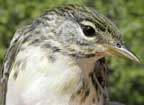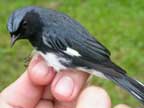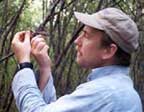|
|
 |
||||
|
Volume 13, Issue 17 ~ April 27 - Nay 4, 2005
|
|||||
|
Bay Country hosts many songbirds that we can see, but also many others that we often only hear. “If more people were able to recognize songbirds calls, they’d be amazed at the variety of birds in their area,” says Pete Marra, a terrestrial animal ecologist at the Smithsonian Environmental Research Center in Edgewater. I tested Marra’s assertion on a morning walk to the neighborhood common. It is a small open area well separated from the houses. Lyons Creek and a marsh border it on one side; woods with tall, mature trees flank the other three: good bird habitat. Plopping down on a hard picnic table, I close my eyes, forcing myself to rely on my ears. Music surrounds me. I distinguish at least six different bird songs. Others, not quite as distinct, drift to me from a distance; not the songs of birds that gather at my feeders; I know them. These strange songs come from neighbors I have lived with for over 13 years. Yet because I could not see them, I don’t know who they are. I am not educated enough to recognize their voices. I open my eyes to follow a melody up to the still-leafless treetops. The bird sings clear, liquid notes, yet, try as I might, I cannot spot the musician. Even with so few places to hide, this songbird remains anonymous. I have only seen a few of the reclusive songbirds that live near me. Scarlet tanagers are fairly common in Bay Country, but I’ve seen only one. Years ago, I noticed a bright red movement out of the corner of my eye. The bird landed on an exposed branch for an instant before melting into the surrounding green foliage. In this glimpse, I barely noticed that its wings were jet black and its shape not at all like a cardinal’s: just enough information to identify it as a scarlet tanager. According to Marra, this isn’t unusual. “Many songbirds are very cryptic. They often have coloring that blends into their surroundings or they live where we can’t see them, like high in treetops or in dense marsh vegetation. They’re hard to spot.” Even birds as brilliant as a male scarlet tanager. Problems, Problems Everywhere Many songbird populations are in decline, but not all. “This is a complicated issue,” says Dr. Chandler S. Robbins, wildlife research biologist at the United States Geologic Service Patuxent Wildlife Research Center in Laurel. “Some species are in decline, some are staying about the same and some are actually increasing. It depends on their habitat and how well they can adapt to humans.” Robbins gives the example of the cardinal, which lives here year round. The cardinal has adapted well to living with humans, so its numbers are on the rise. On the other hand, Robbins has seen a big decline in local grassland songbirds. On his drive between work and home in Howard County, new housing areas have supplanted pasturelands at a steady pace. Grassland songbirds have all but disappeared along the route. “The pastures are just gone,” Robbins says. “And the meadowlarks and red-winged blackbirds with them.” Here in Bay Country, pastures and meadows are also disappearing, but at least for now, we have more than Robbins sees on his drive home. When Robbins asks me when I last saw a horse or cow, I feel privileged to answer that I see them almost every day. I’ve never seen a meadowlark, but I’ve seen several red-winged blackbirds in northern Calvert and southern Anne Arundel counties. Calvert birder Arlene Ripley, who tracks birds more carefully than I, tells me I am optimistic. According to her, our local birds have also plummeted as new neighborhoods, sports fields and shopping areas are built to meet the needs of a growing human population. She especially laments a new shopping area in Dunkirk. “I used to go there so often to enjoy nature,” Ripley says. “Now it is just awful.” Marra, who researches the American redstart, black-throated blue warbler and ovenbird (all migrants to the tropics), agrees that the problem is challenging. “In my research, we are working to understand the factors that drive population dynamics,” he says. “Food, weather, predation and habitat all influence the probability of survival, and they’re all interrelated.” So many factors impact the survival of birds that even scientists struggle to determine which of many factors is most significant.  Backyard Data May Tell Backyard Data May TellOne of the problems may be how much we don’t know. Robbins pioneered the North American Breeding Bird Survey in 1966. Legions of volunteers report bird sightings to populate this database. It is an excellent tool to track general trends in bird populations, but even Robbins admits it has its limitations because it doesn’t cover all areas. The loss of pastures between Laurel and Howard County reduced the bird population living in that specific area, but loss of habitat in Howard County would not directly impact the birds in my neighborhood. Robbins is now leading an effort to obtain more specific, comprehensive information for Maryland. His Maryland Breeding Bird Atlas repeats a similar study conducted 20 years ago. For both era’s studies, the state was divided into some 1,500 survey blocks of roughly three square miles each. In 2001, bird experts began a five-year project to count the birds within each block. Once complete, the atlas will provide the detailed information researchers need to assess the effects of specific local events on the birds living in those areas. “This is really an excellent study,” Robbins says. “It’s on a state scale, and every homeowner lives in an atlas block. It brings the issue into everyone’s backyard.” Migration’s Perilous Journey Many Bay Country songbirds are migratory, and that’s where many of the problems come in — though plenty are here in our own backyards. Some of these migrants, like my glimpsed scarlet tanager, get the name neotropical because they journey every winter to tropical habitats in Central and South America and the Caribbean Islands. Some migrations are spectacular. The purple martins that dive and dip above the waters of Chesapeake Bay and Patuxent River during our summer are champion migrants. They trek all the way to South America. Some may even fly to Argentina, a one-way distance of 6,000 miles. Migration takes a huge amount of energy and time. Many birds spend half their lives migrating between their breeding grounds and their winter habitat. Some even embark on ambitious over-water journeys that last for days. In the spring, flocks of small Blackpoll warblers pass right through Washington, D.C., on their standard northbound migration. But the warblers’ fall migration is awe inspiring. Taking advantage of favorable winds, the birds fly from the New England coast to the tropics in a single 80- to 90-hour trek covering 2,000 to 2,500 miles. During the journey, the bird does not eat, sleep, drink or rest. This feat is comparable to a human running consecutive four-minute miles for more than three days. The ruby-throated hummingbird zipping through your garden to dip its long bill into your fuchsia flowers may have flown from the Yucatan Peninsula in Mexico to the U.S. Gulf Coast in a single 24-hour over-water flight of some 600 miles. Not bad for a bird that weighs about the same as a penny. In addition to being long and hard, migration is fraught with peril: predators, bad weather and human-made obstacles among them. Scientists estimate that only one-half of the migratory birds you see this summer will survive to return next year to breed.  Perfect Flying Machines Perfect Flying MachinesIf it’s so hard and dangerous, why do birds migrate? Simple: The benefits outweigh the risks. Migration allows birds to take advantage of seasonally abundant food, especially in the spring when migration and breeding are timed to the emergence of a bumper crop of insects. The birds also avoid the cold, winter weather by flying south, some of them to warm, tropical rain forests. As fantastic as are the journeys these creatures undertake, even more fantastic are the adaptations that allow them. Birds’ bodies are light and streamlined. They have extremely well developed pectoral muscles to power their wings. Their huge hearts proportionately weigh six times more than a human heart; their respiratory systems are the most efficient in the animal kingdom. Together, heart and lungs deliver the volumes of oxygen necessary to fuel the pectoral muscles that take these birds on such long, arduous journeys. In short, birds are perfect flying machines. What Went First: The Rainforest or the Bird? The perilous journey of many Chesapeake neotropical migrants does not always end in a safe haven. The devastation of rain forests in Central and South America has been relentless for decades. But how much does it affect these migrants? Some researchers believe the loss of northern breeding habitats in our backyard have reduced migrant songbird populations so much that tropical destruction is not the limiting factor. Robbins is in this camp. “No doubt we’re losing rain forests,” he says, “but I still don’t think that is the major factor impacting migratory birds. Lots of neotropical migrants don’t even winter in rain forests; and many of those that do seem to be able to use fragmented sections of rain forest that the local birds have abandoned. Destruction of our local breeding habitats is still more important.” Marra is not so sure. “At this point, my research indicates that winter events seem to be pretty important,” he says. “But even that varies from species to species.” Needed: Rest Stops on the Migratory Highway Just as important as good destination are accommodations along migration routes. While many birds like the Blackpoll warbler journey for long, uninterrupted distances, they need to rest and refuel en route. Rest stops are especially important in the spring, when birds must arrive at their breeding areas in shape to establish a territory, mate and face the rigors of parenthood. My first spring in Calvert County, I awoke early one Saturday morning  to hear a soft scrapping and fluttering against my bedroom window. An Eastern phoebe male was ardently defending his territory against a determined intruder: his own reflection. Imagine the bird’s surprise when he found his rival unexpectedly hard, cold and flat. to hear a soft scrapping and fluttering against my bedroom window. An Eastern phoebe male was ardently defending his territory against a determined intruder: his own reflection. Imagine the bird’s surprise when he found his rival unexpectedly hard, cold and flat.After beating himself against the window over and over, the phoebe retreated some 10 feet away to perch on a railing. Breathing hard and flicking his tail in anger, he was seven inches of indignation clothed in olive brown-feathers. Once rested, he re-engaged his adversary with vigor. Every morning for about a week, the battle continued. Arriving early enough to claim and defend a territory is crucial for birds. If a male cannot establish a territory, he cannot attract a female. If he cannot attract a female, he cannot breed and his lineage dies out. Anything that delays a bird’s arrival to its breeding grounds or effects its strength when it arrives can reduce that bird’s chances — especially if the bird, like my Eastern phoebe, has to routinely fight an adversary as large and immovable as a windowpane. Some of our migrants make their stops along the coast of the Gulf of Mexico. For birds that fly over water between Central and North America, the Gulf Coast is the first and often a critical opportunity to rest and feed. After this initial landfall, many species fan out across the eastern half of the U.S., feeding on bountiful insects as they move north. Coastal regions are prime habitats for humans, too. Half the population of the U.S. now lives within 50 miles of a coast; that number is expected to grow, especially along the Gulf of Mexico where humans flock in retirement. High-rise condominiums now replace bird stopover habitats, forcing migratory birds to fly farther to rest and refuel — if they have the strength. Closer to home, thousands of birds stop over along the Delaware, Maryland and Virginia Atlantic coast after over-water flights from New England and Canada. Birds normally prefer to fly farther inland to rest and feed, which is a good thing as most of the beach is now covered with hotels and condominiums. But it isn’t always possible to fly farther inland. A few times each fall, strong western winds may blow birds off course so that come dawn they find themselves far offshore. The birds must then fly straight in to the beach. Robbins describes how even in highly populated areas, like Ocean City, hundreds of small birds can be seen flying toward the beach only a few feet above the waves. When they land on the sand, they are so spent that they don’t even move when humans approach. They have no safe place to hide until they recover enough to move inland.  Home Is Not Always So Sweet Home Is Not Always So SweetWhen the long journey of spring migrants is done, they come home to problems in the summer breeding grounds, too. Humans are the birds’ biggest competitors. Open spaces are disappearing quickly, and their bird residents with them. Along with open spaces, we’re forever losing forests, with what remains becoming more and more fragmented. “When developers come in, the first thing most of them do is take out all the trees,” says Robbins. Forests in the Mid-Atlantic were first fragmented when early settlers created farmlands in the wilderness. Fragmentation has continued until over the last few decades, ex-burbs far from cities have left only islands of remaining forests. Fragmented forests are problems in more ways than one. First, many songbirds need thick vegetation. Second, the longer fringes of fragmented forest make cowbirds a bigger menace. Cowbirds are brood parasites, meaning they don’t raise their own young. Like Mayzie the lazy mother bird in Dr. Suess’ book Horton Hatches the Egg, cowbirds find it far more convenient to lay an egg in another bird’s nest and let a foster family do all the work. Before European settlement, the cowbird lived on the prairie where flocks followed buffalo herds, eating insects the grazing animals flushed out of the grass. As settlers moved across America, they created corridors of open pastures and introduced cattle. The cowbird transitioned from buffalo to cattle and used the pastures to expand its range throughout the eastern United States. The nests cowbirds like best belong to forest-dwelling songbirds. Envision a female cowbird perched near the edge of the woods. She is waiting to locate a songbird nest. Patience is key. The cowbird’s dull coloring makes her inconspicuous. The songbirds darting back and forth to their nests never see her. Once the female cowbird knows where the nest is, she returns during the egg-laying period to leave one of her eggs. Clever creature, she often removes a songbird’s egg to make it less likely that the returning bird will notice the new addition. Cowbirds have advantages over the songbirds. Cowbird eggs hatch a few days faster than their hosts’ eggs, ensuring the cowbird chick a head start in the critical competition for food. Also, cowbirds parasitize smaller species. The cowbird chick grows quickly, sometimes crowding its host siblings out of the nest before they are ready to fledge. Only nine host songbirds reject cowbird eggs. These larger birds have the strength to remove the unwanted egg. The smaller yellow warbler, one of the principal victims of cowbirds, buries the unwanted egg (along with any of its own eggs) with new nest material and starts over. But starting over is a big energy investment, made even larger by the cowbird’s persistence. Researchers have found some yellow warbler nests with as many as six layers of nest material, each one containing at least one cowbird egg. It would be bad enough if a cowbird did this to one nest. But each female cowbird may lay as many as 30 or 40 eggs in different nests each season.  Doing Our Part Doing Our PartMakes you mad, doesn’t it? You can’t change a cowbird’s habits, but you can change yours. Cat lovers won’t like Marra’s first suggestion. “Keep your cats inside,” he says. “Cats are an invasive species and take a huge toll on the birds.” Marra’s other suggestions are less controversial. You can turn your yard into a bird haven. Plant thick shrubs to grow hiding places and berry-producing trees and shrubs to serve food. Don’t forget flowering plants for hummingbirds. (See www.nestbox.com for some suggestions.) You could donate money to any of several conservation groups that work to save birds and their habitats: Partners in Flight, Western Hemisphere Shorebird Reserve Network, American Bird Conservancy, National Audubon Society and Nature Conservancy. Watching my birds, I realize that after all the research I’ve done, I still don’t know why I’m blessed with so many birds despite all the problems. One thing is clear though: forests and fields make better homes for birds than do shopping areas and housing developments. As we humans continue to colonize Chesapeake Country, the bird populations will change, often to their detriment and ours. What more can I do, I wonder? As I inhale the aroma of my coffee, I realize there is a way for me to help the rain forests, too. It’s a way that is relatively easy. Traditionally, coffee was grown under the shade of a lush forest canopy where many birds and animals could make their homes. Economic pressures are pushing coffee growers to switch to sun plantations, which have no forest overstory. Sun plantations produce much higher yields, but they are not sustainable without expensive crop management. Without the shading trees, these plantations provide little habitat for wildlife. Conservation groups are working to encourage growers to stick with or return to traditional growing methods. To do this they have established certification programs for shade-grown coffee. Two such programs are ECO-OK, certified by the Rain Forest Alliance, and Bird Friendly® shade-grown coffee, certified by the Smithsonian Migratory Bird Center. Among many things, these programs authorize seals on packages of coffee to verify that they are shade-grown. I take a long sip of my coffee and remind myself to look for shade-grown seals. If you do too, these labels can influence the coffee-growing industry the same way dolphin-friendly seals changed the practices of the tuna industry.
|
|||||
|
© COPYRIGHT 2004 by New Bay Enterprises, Inc. All rights reserved. |

 Where Have All the Songbirds Gone?
Where Have All the Songbirds Gone?
 What Is a Songbird Anyway?
What Is a Songbird Anyway?
 About the Author
About the Author